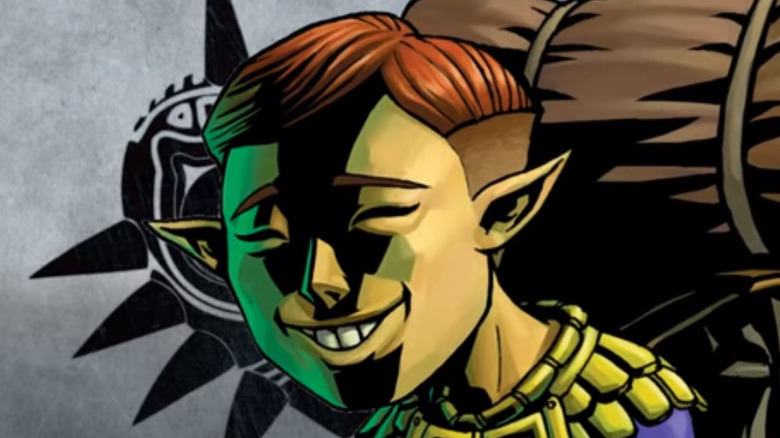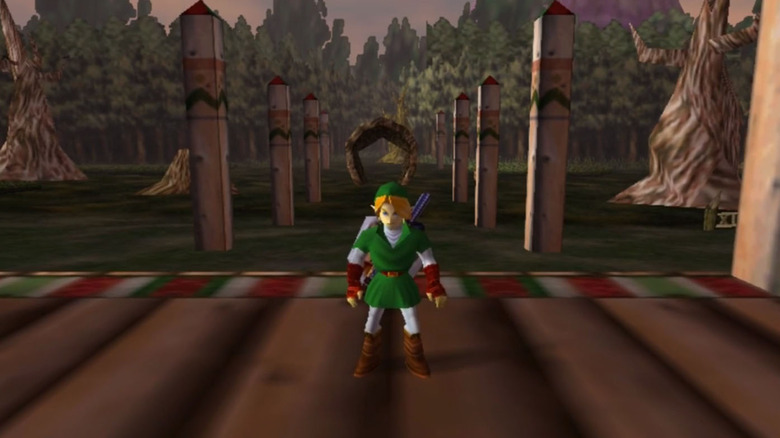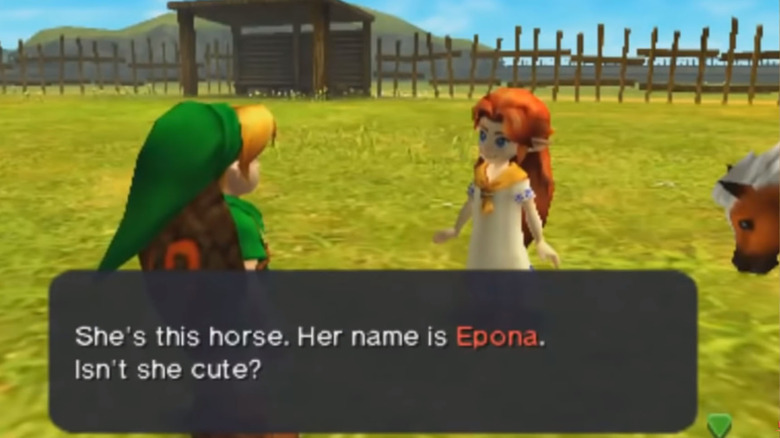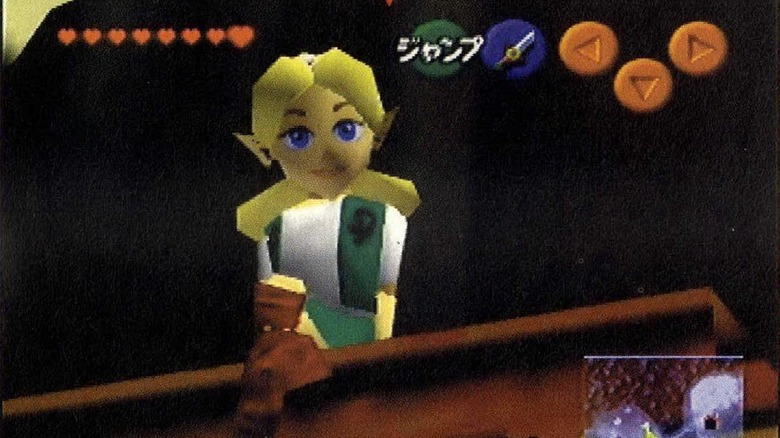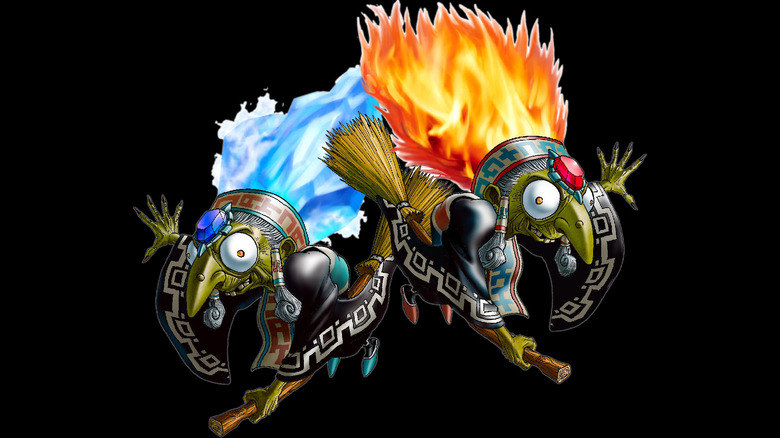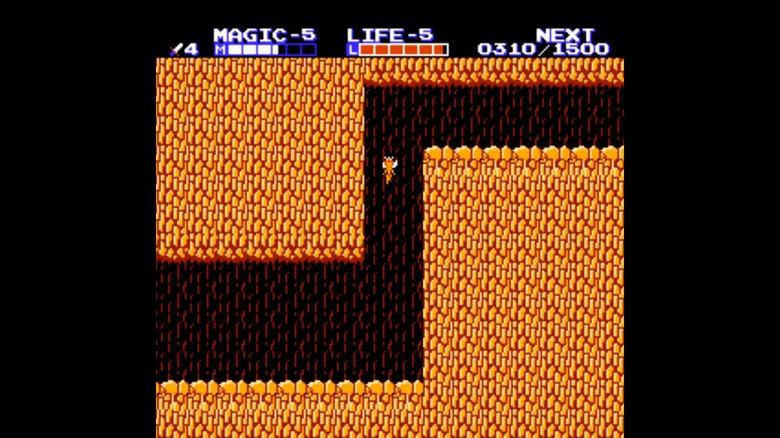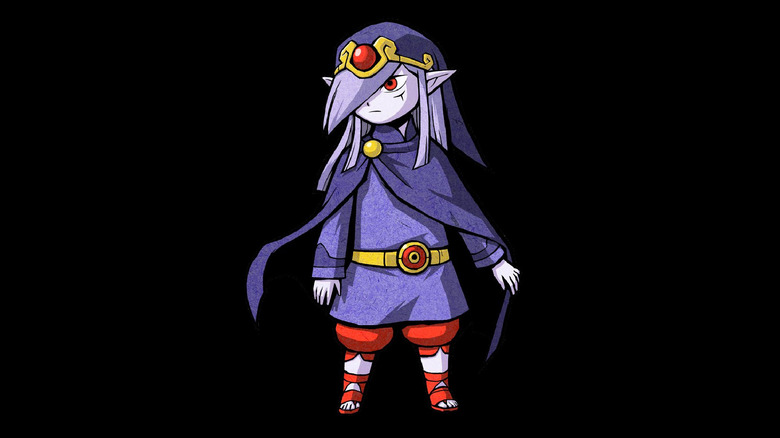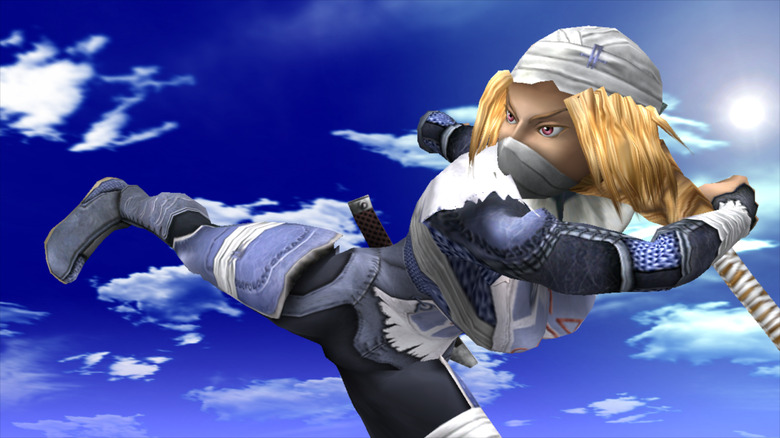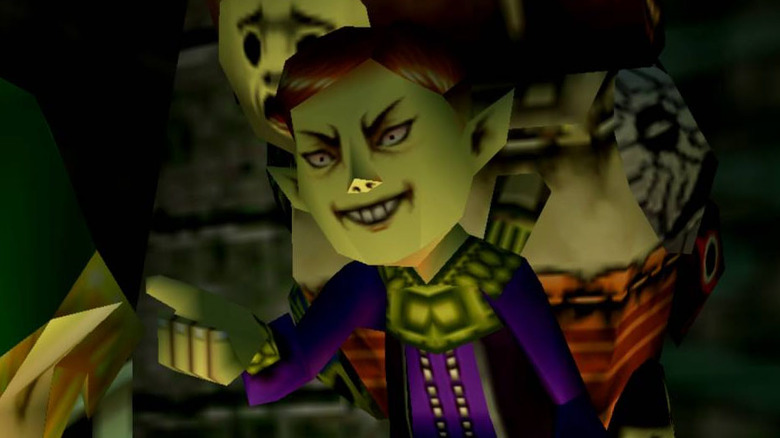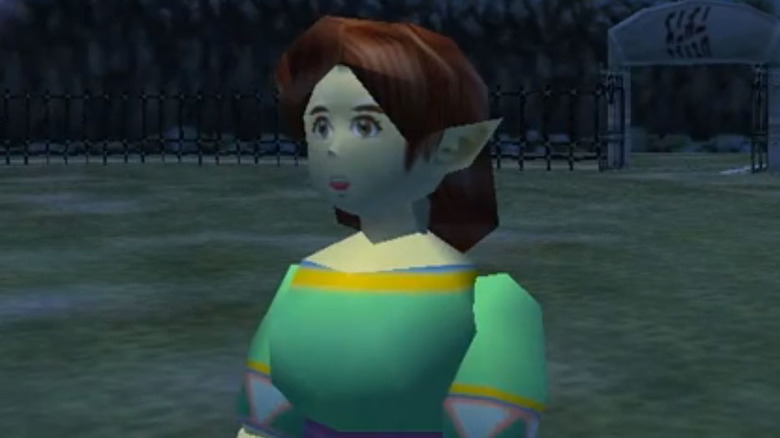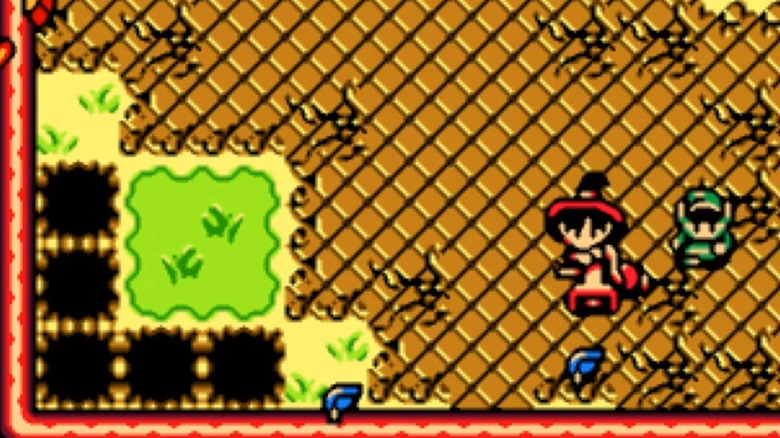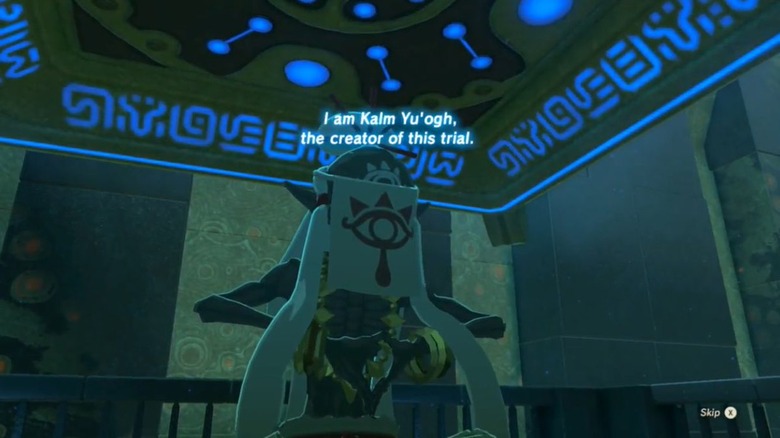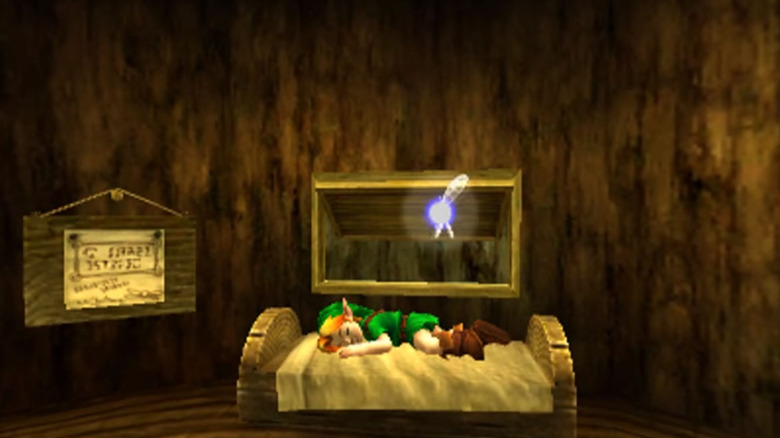Characters That Were Cut From Zelda Games And Nobody Noticed
The Legend of Zelda is a big franchise made up of big, dense games. Over the years, hundreds of characters have joined Link, Zelda, and Ganon in their battle over the Triforce and control of Hyrule. Naturally, some of them disappeared from the series after a while. Others didn't even make it past the development phase, and were cut before their respective games were even released.
It's hard to blame Nintendo for not giving these folks their due, and it's not your fault if you didn't realize that these characters went missing. With such a large cast, it's almost impossible to keep track of every man, woman, and creature who has appeared in the Zelda franchise, especially when they only appeared in betas and early versions of the game. The following characters were either cut from a game during development, or disappeared after making a few memorable appearances, but don't blame yourself if you didn't notice. You're not alone.
It's Link, but all grown up
Every Zelda game has a hook. In A Link to the Past, it's inter-dimensional travel. In Ocarina of Time, it's time travel, so you spend half of your time playing as Young Link, who is still a child, and the other half as Adult Link, his fully-grown counterpart. Technically, they're both the same character, but games like Super Smash Bros. and Hyrule Warriors treat them like separate entities with their own, separate personalities, so fans tend to, too.
Young Link made an encore appearance in Majora's Mask, Ocarina of Time's direct sequel, but his older equivalent did not. At one point, he was supposed to. The Legend of Zelda: Hyrule Historia, Nintendo and Dark Horse Comics' authoritative compendium of everything Zelda, calls explicit attention to some mysterious Majora's Mask concept art featuring Adult Link, positing that "perhaps they were prototypes" of one of Link's mask-driven alternate forms. In addition, early versions of the game contained something called the "Adult's Mask." It's not hard to put two and two together.
Allegedly, Adult Link was also supposed to appear in The Legend of Zelda: The Wind Waker. A piece of supposed concept art that's been floating around online for years shows Toon Link growing up, usually alongside rumors that The Wind Waker was originally going to see Link transform from a kid into an adult. It's hard to find official verification for either, however, so don't take this as a cold, hard fact. Still, it's fun to imagine what could've been.
The rancher's daughter (and the rancher's daughter's father)
The Legend of Zelda: Ocarina of Time didn't just introduce players to Epona, Link's horse. It also featured the debut of Malon, one of Link's many potential love interests, and her father Talon, who manages Lon Lon Ranch. In fact, it's Malon and Talon who give Link his trusty steed, instantly making them some of the most iconic and memorable characters in the entire Zelda franchise.
That's why it's a little weird that they only appeared in four games (not counting occasional cameos as Super Smash Bros. collectibles), and that we haven't seen them for almost 15 years. The Legend of Zelda: The Minish Cap marks Malon's and Talon's final appearances (Lon Lon Ranch hasn't shown up again either, although the milk vendor from A Link Between Worlds says he buys his wares there, and Breath of the Wild's Ranch Ruins seem to be a post-apocalyptic version of the homestead). That doesn't mean that Malon and Talon have been forgotten, however. Their spirits live on, although it gets a little confusing.
See, Malon and Talon were originally conceived as alternate versions of Marin and Tarin from Link's Awakening, which came out before Ocarina of Time but chronologically takes place afterwards. You can find Marin and Tarin in 2019's Switch-exclusive Link's Awakening remake, and Marin pops up as a playable character in Hyrule Warriors, too.
Fado to black
There is a character called Fado in The Legend of Zelda: Ocarina of Time. She's the blond-haired Kokiri who has an odd, eerie obsession with the Lost Forest. However, evidence indicates that Fado was originally supposed to be a very different, and that her role was cut down so severely that she basically became a different character.
Fado already stands out as one of the few Kokiri with a unique character model, but in early Ocarina of Time screenshots, the young lass looked even more unique. That "beta" version of Fado was restored by ROM hackers in 2009, but her altered appearance is just the tip of the iceberg. Hackers have also discovered traces of a "Wind Temple" that looks like it was ultimately replaced by the Forest Temple, and put two and two together to surmise that Fado was supposed to be the Wind Sage in her original form.
That's never been officially confirmed, but the evidence is pretty convincing, especially when you look The Wind Waker. In that game, a blond Kokiri named Fado actually is the Wind Sage (or was, anyway, until he died). Given how the Zelda franchise likes to recycle and reinvent ideas, it seems pretty clear that Ocarina of Time's Fado had a more important fate in store, only to be robbed of her potential by unknown concerns during development.
If you think Ganon's bad, wait until you meet his parents
Everyone has a family, even Ganondorf, The Legend of Zelda's recurring big bad. In Ocarina of Time, we met Koume and Kotake — or, as they're known collectively, Twinrova — two Gerudo witches who adopted Ganondorf and served as his surrogate parents. As players learn, the two sorceresses are both over 400 years old and are as evil as they come. Not only did they kidnap and brainwash the Gerudo warrior Nabooru, but they were Ganondorf's number one supporters in his campaign to conquer the world. They're bad, bad news.
In fact, in the two Oracle games, Koume and Kotake are the main villains. They're behind the plot to light the Flame of Sorrow and the Flame of Destruction in order to resurrect Ganon, and then kidnap Princess Zelda with the aim of sacrificing her in order to complete the ritual. As both Ganon's parents and his most dedicated servants, they're almost as important to The Legend of Zelda's timeline as Ganon himself. You'd think that they'd be a big deal.
They're not. Outside of those three games — plus Majora's Mask, where their alternate-reality Terminian counterparts end up being relatively harmless — the dastardly duo haven't appeared much at all. Twinrova is a collectible trophy in Super Smash Bros. for Nintendo 3DS and, well, that's about it. Ganon is always going to be Link's number one enemy, but Koume and Kotake have a lot of potential, too. We're just not sure Nintendo is ever going to let them reach it.
The sidekick that wasn't
Okay, okay, we know: Zelda games are lousy with fairies. Try as he might, Link just can't escape them. This one specific fairy, however, was set to play a major role in the legendary hero's third adventure — only to be scrapped when the game went in a totally different direction.
In 1989, The Legend of Zelda creator Shigeru Miyamoto and Dragon Quest creator Yuji Horii interviewed each other about their respective series. In hindsight, the conversation is fascinating. When Miyamoto starts talking about "Zelda 3," he mentions that the game was going to star an entire party of heroes, JRPG-style. Link would still be in the game (or, at the very least, a protagonist who is "a mix between an elf and a fighter," which sure sounds like Link), but he would be accompanied by both "a magic user" and "a girl who looked a little like a fairy and whose role consisted of reconnaissance."
Neither of those side characters appeared in The Legend of Zelda: A Link to the Past, although the fairy-like girl did make her way into a Zelda game — sort of. The fairy used in NES' Zelda 2: The Adventure of Link was based on the design created for Zelda 3, although the 8-bit sprite is so small that it's hard to imagine what she would've looked like on the more powerful Super Nintendo console.
Hyrule's OG villain
You know Ganon (and his slightly less-monstrous alter-ego, Ganondorf), the King of Thieves, the Prince of Darkness, and the Scourge of Hyrule Castle, but do you know Vaati, the Wind Mage and Immortal Demon? You should. According to the official The Legend of Zelda chronology, Vaati, not Ganon, was the franchise's first recurring big bad. After Link and Zelda defeated Demise and founded Hyrule in Skyward Sword, a Minish citizen called Vaati traveled to the kingdom in order to hunt down the powerful Light Force and rule the world.
Link beats Vaati in The Minish Cap, but that's not the end of the pint-sized sorcerer. Vaati appears again in The Legend of Zelda: Four Swords, where he declares himself the Wind Sage and steals a few maidens, including Princess Zelda, in his quest for power. Then, and only then, does Ganon enter the picture. In Four Swords Adventures, which takes place years later, Vaati and Ganondorf team up with Shadow Link to cause even more trouble.
From the timeline laid out in the Hyrule Historia, it's clear that Vaati is just as much of a threat to as Ganon. Heck, he was plaguing Hyrule centuries before Ganondorf was even born. He's also the only main villain other than Ganon to antagonize Link across multiple games. Don't go looking for him in recent titles, though. Despite his pedigree, Vaati hasn't been seen for almost 15 years. Despite fan requests, he hasn't even appeared in Super Smash Bros. — and when he does return, we don't expect that he'll be too happy about that.
Princess Zelda's stealthy alter-ego returns -- or doesn't
It took a while, but The Legend of Zelda: Ocarina of Time finally confirmed what we'd suspected all along: Princess Zelda is a stone-cold badass. Sure, when she's in her civilian guise, Zelda spends most of her time ruling kingdoms and getting kidnapped — but, like many great heroes, she has a secret identity. While Link spends seven years slumbering in the Chamber of Sages, someone needs to step up to keep Hyrule safe. And so, Zelda slips into a disguise, escapes Ganondorf, and rechristens herself Sheik, a gender-ambiguous ninja who's equally at home casting spells as she is playing the lyre.
It's easy to see why Sheik has become such a popular character despite the fact that she's only appeared in one canonical Zelda game (no, Hyrule Warriors and Super Smash Bros. don't count), which is why it's not all that surprising that Nintendo's Zelda team originally wanted to put Sheik in The Legend of Zelda: Twilight Princess, too. Unfortunately, those plans were abandoned early on — even the Hyrule Historia's Sheik concept art draws from a second-hand rendition of Sheik's Twilight Princess costume, not the original design — for unknown reasons.
Still, if you want a look at what could've been, Sheik's Super Smash Bros. Brawl outfit is directly based on her proposed Twilight Princess design. There are a few references to Sheik in the final game, too: when she's imprisoned, Princess Zelda wears a cloak featuring the Sheikah emblem, referencing the girl's shadowy alter-ego.
The mask salesman that'll make you anything but happy
Forget Tingle. If you're looking for The Legend of Zelda's creepiest character, you don't need to search any further than the Happy Mask Salesman. Not only does the Happy Mask Salesman hand out dangerous magical objects without a care, but his unsettling smile, his mysteriously comprehensive knowledge of everything that Link does or will do, and his hair-trigger temper make him one of the most memorable — and most frightening — characters in the entire Zelda canon.
The Happy Mask Salesman's enigmatic nature has paved the way for all kinds of conspiracy theories. Is he one of the powerful Ancient Ones? Is he a Hylian god trapped on the mortal plane? Is he a long-lost member of the Sheikah race? Is he an in-game representation of The Legend of Zelda creator Shigeru Miyamoto himself? Chances are, we'll never know. Despite creeping out an entire generation of Zelda fans in Ocarina of Time and (especially) Majora's Mask, the Happy Mask Salesman disappeared after a brief appearance in the Game Boy-exclusive Oracle of Ages, leaving his true motives a mystery.
From Aria to Saria
It's been over 20 years, but according to Metacritic, The Legend of Zelda: Ocarina of Time is still the very best video game ever made. To this day, the game is still wildly popular, which is why data miners and ROM hackers continue to dissect it. While delving through the game's code, those diehard fans found an unused character in the game that they've nicknamed Aria, and they think they've discovered what her role was supposed to be.
See, a very similar character appeared in early Ocarina of Time demos, when the game was running on a lightly modified version of the Super Mario 64 engine. The white-clad NPC, who can be found in a few different locations around the demo's village, was allegedly going to give Link tips on how to proceed. Aside from Link, Aria is the only human-like character in this early version of the game. Either that means that she was going to play a major role, or she's a placeholder that Nintendo's developers used for testing. Both seem equally likely.
Fans surmise that the woman in white is an early version of Aria, who many assume was replaced by Link's childhood friend Saria. Aria has a link (no pun intended) to another classic Zelda character, too: as keen observers note, her clothes look an awful lot like those worn by Marin, Link's musically-inclined love interest in The Legend of Zelda: Links Awakening.
The name is Syrup. Maple Syrup.
If you've made it this far, you've probably noticed a trend: lots of great characters appear in the dual Oracle of Ages and Oracle of Seasons games, and then disappear almost immediately afterwards. Maybe that's because those two games were developed by Capcom, and not Nintendo. Maybe it's because they were Game Boy games that came out in 2001, just a month before the Game Boy Advance arrived and stole its predecessor's thunder.
Whatever the reason, you can add Maple to the long list of Zelda characters that have tons of promise but disappeared from the series with nary a trace. That's too bad, because the young witch is remarkably charming. Every time that you kill 30 enemies (or 15, if you're wearing a special item), Maple swoops down on her broomstick. Unfortunately, she's not a great pilot. When Maple bumps into Link, both of them drop all of their items. Link can take that opportunity to score some of Maple's rare loot (including a Piece of Heart), while Maple upgrades her ride to a vacuum cleaner — and, later, a UFO — if she gets enough of Link's rupees.
That's quirky in the best Legend of Zelda tradition, and we'd love to see Maple make a return appearance. So would her grandmother, Syrup, a potion-brewing witch who had a slightly longer career, but still hasn't been seen since The Legend of Zelda: The Minish Cap debuted in 2005.
Monks so nice they renamed them thrice
The Legend of Zelda: Breath of the Wild isn't a traditional Zelda game. Instead of filling long, sprawling dungeons with monsters and puzzles, Breath of the Wild breaks its brainteasers and combat challenges up into bite-sized pieces and hides them away in shrines scattered across Hyrule. At the end of every shrine, a monk bestows the young hero with a Spirit Orb in addition to whatever treasures he unlocked along the way.
There are 120 shrines in Breath of the Wild (136 with DLC), which means that there are an equal number of monks waiting for Link to stop by and visit. Unsurprisingly, a few of them didn't survive development. At E3 2016, where Nintendo devoted its entire booth to Breath of the Wild, players met Kalm Yu'ogh, Kam Yatakh, and Ke Numut. In the final game, those holy men were replaced by Kam Urog, Kaam Ya'tak, and Kah Namut respectively. We're talking about more than just a few name revisions, too. The old monks sat in different positions than their replacements and had slightly different designs.
Is this a drastic rewriting of Zelda lore? Of course not. Still, the old monks look just fine to us, and the changes show just how dedicated Nintendo is to getting even the smallest details just right.
Hey! Listen!
Anyone who's played The Legend of Zelda: Ocarina of Time knows Navi, Link's "helpful" fairy companion. You can't miss her. Ostensibly, Navi's there to make Link's journey a little easier by explaining Ocarina of Time's gameplay to players, but her advice is as basic as it gets, and she repeats herself endlessly. Even worse, her high-pitched chirps for attention are constant and supremely irritating, often undercutting Ocarina of Time's somber mood.
Still, Navi sticks with Link through the entire game. On the whole, players have spent more time with her than they have with Ganon, Tingle, or even Princess Zelda herself. And yet, despite Navi's critical role in the most popular Zelda game ever made, Navi has never appeared outside of Ocarina of Time (there's a fairy in Hyrule Warriors that the North American release refers to as Navi, but the creature is just called "fairy" in the European and Japanese editions, so it's probably not supposed to be her).
On one hand, Navi probably deserves better. On the other, she regular tops lists of the most obnoxious video game characters ever, so maybe — just maybe — her prolonged absence is less of a cut and more of a blessing. We're certainly not complaining.

